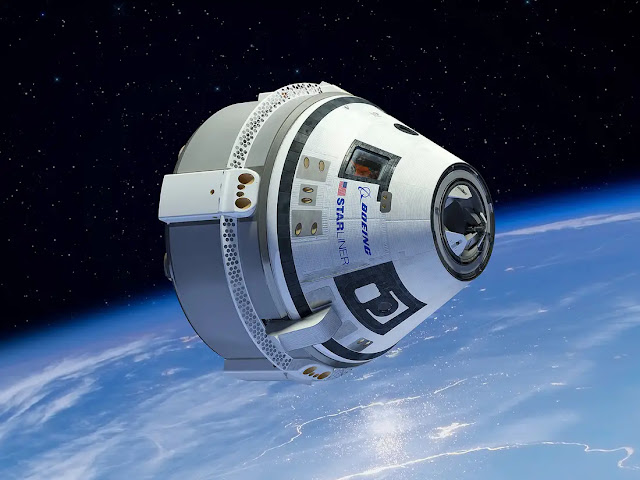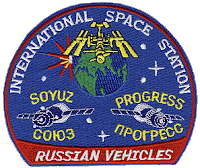NASA - OSIRIS-REx Mission patch.
Oct. 8, 2020
NASA’s first asteroid sample return mission now knows much more about the material it’ll be collecting in just a few weeks. In a special collection of six papers published today in the journals Science and Science Advances, scientists on the OSIRIS-REx mission present new findings on asteroid Bennu’s surface material, geological characteristics, and dynamic history. They also suspect that the delivered sample of Bennu may be unlike anything we have in the meteorite collection on Earth.
These discoveries complete the OSIRIS-REx mission’s pre–sample collection science requirements and offer insight into the sample of Bennu that scientists will study for generations to come.
Tour of Asteroid Bennu
One of the papers, led by Amy Simon from NASA’s Goddard Space Flight Center in Greenbelt, Maryland, shows that carbon-bearing, organic material is widespread on the asteroid’s surface, including at the mission’s primary sample site, Nightingale, where OSIRIS-REx will make its first sample collection attempt on October 20. These findings indicate that hydrated minerals and organic material will likely be present in the collected sample.
This organic matter may contain carbon in a form often found in biology or in compounds associated with biology. Scientists are planning detailed experiments on these organic molecules and expect that the returned sample will help answer complex questions about the origins of water and life on Earth.
“The abundance of carbon-bearing material is a major scientific triumph for the mission. We are now optimistic that we will collect and return a sample with organic material – a central goal of the OSIRIS-REx mission,” said Dante Lauretta, OSIRIS-REx principal investigator at the University of Arizona in Tucson.
Authors of the special collection have also determined that carbonate minerals make up some of the asteroid’s geological features. Carbonate minerals often precipitate from hydrothermal systems that contain both water and carbon dioxide. A number of Bennu’s boulders have bright veins that appear to be made of carbonate – some of which are located near the Nightingale crater, meaning that carbonates might be present in the returned sample.
The study of the carbonates found on Bennu was led by Hannah Kaplan, from Goddard. These findings have allowed scientists to theorize that Bennu’s parent asteroid likely had an extensive hydrothermal system, where water interacted with and altered the rock on Bennu’s parent body. Although the parent body was destroyed long ago, we’re seeing evidence of what that watery asteroid once looked like here – in its remaining fragments that make up Bennu. Some of these carbonate veins in Bennu’s boulders measure up to a few feet long and several inches thick, validating that an asteroid-scale hydrothermal system of water was present on Bennu’s parent body.

Image above: During fall 2019, NASA’s OSIRIS-REx spacecraft captured this image, which shows one of asteroid Bennu’s boulders with a bright vein that appears to be made of carbonate. The image within the circle (lower right) shows a focused view of the vein. Image Credits: NASA/Goddard/University of Arizona.
Scientists made another striking discovery at site Nightingale: its regolith has only recently been exposed to the harsh space environment, meaning that the mission will collect and return some of the most pristine material on the asteroid. Nightingale is part of a population of young, spectrally red craters identified in a study led by Dani DellaGiustina at the University of Arizona. Bennu’s “colors” (variations in the slope of the visible-wavelength spectrum) are much more diverse than originally anticipated. This diversity results from a combination of different materials inherited from Bennu’s parent body and different durations of exposure to the space environment.
This paper’s findings are a major milestone in an ongoing debate in the planetary science community – how primitive asteroids like Bennu change spectrally as they are exposed to “space weathering” processes, such as bombardment by cosmic rays and solar wind. While Bennu appears quite black to the naked eye, the authors illustrate the diversity of Bennu’s surface by using false-color renderings of multispectral data collected by the MapCam camera. The freshest material on Bennu, such as that found at the Nightingale site, is spectrally redder than average and thus appears red in these images. Surface material turns vivid blue when it has been exposed to space weathering for an intermediate period of time. As the surface material continues to weather over long periods of time, it ultimately brightens across all wavelengths, becoming a less intense blue – the average spectral color of Bennu.
The paper by DellaGiustina et al. also distinguishes two main types of boulders on Bennu’s surface: dark and rough, and (less commonly) bright and smooth. The different types may have formed at different depths in the parent asteroid of Bennu.
Not only do the boulder types differ visually, they also have their own unique physical properties. The paper led by Ben Rozitis from The Open University in the UK shows that the dark boulders are weaker and more porous, whereas the bright boulders are stronger and less porous. The bright boulders also host the carbonates identified by Kaplan and crew, suggesting that the precipitation of carbonate minerals in cracks and pore spaces may be responsible for their increased strength.

OSIRIS-REx probe. Image Credit: NASA
However, both boulder types are weaker than scientists expected. Rozitis and colleagues suspect that Bennu’s dark boulders (the weaker, more porous, and more common type) would not survive the journey through Earth’s atmosphere. It’s therefore likely that the returned samples of asteroid Bennu will provide a missing link for scientists, as this type of material is not currently represented in meteorite collections.
Bennu is a diamond-shaped pile of rubble floating in space, but there’s more to it than meets the eye. Data obtained by the OSIRIS-REx Laser Altimeter (OLA) – a science instrument contributed by the Canadian Space Agency – have allowed the mission team to develop a 3D digital terrain model of the asteroid that, at 20 cm resolution, is unprecedented in detail and accuracy. In this paper, led by Michael Daly of York University, scientists explain how detailed analysis of the asteroid’s shape revealed ridge-like mounds on Bennu that extend from pole-to-pole, but are subtle enough that they could be easily missed by the human eye. Their presence has been hinted at before, but their full pole-to-pole extents only became clear when the northern and southern hemispheres were split apart in the OLA data for comparison.
The digital terrain model also shows that Bennu’s northern and southern hemispheres have different shapes. The southern hemisphere appears to be smoother and rounder, which the scientists believe is a result of loose material getting trapped by the region’s numerous large boulders.

Image above: NASA’s OSIRIS-REx mission created these images using false-color Red-Green-Blue (RGB) composites of asteroid Bennu. A 2D map and spacecraft imagery were overlaid on a shape model of the asteroid to create these false-color composites. In these composites, spectrally average and bluer than average terrain looks blue, surfaces that are redder than average appear red. Bright green areas correspond to the instances of a mineral pyroxene, which likely came from a different asteroid, Vesta. Black areas near the poles indicate no data. Image Credits: NASA/Goddard/University of Arizona.
Another paper in the special collection, led by Daniel Scheeres of University of Colorado Boulder, examines the gravity field of Bennu, which has been determined by tracking the trajectories of the OSIRIS-REx spacecraft and the particles that are naturally ejected from Bennu’s surface. The use of particles as gravity probes is fortuitous. Prior to the discovery of particle ejection on Bennu in 2019, the team was concerned about mapping the gravity field to the required precision using only spacecraft tracking data. The natural supply of dozens of mini gravity probes allowed the team to vastly exceed their requirements and gain unprecedented insight into the asteroid interior.
The reconstructed gravity field shows that the interior of Bennu is not uniform. Instead, there are pockets of higher and lower density material inside the asteroid. It’s as if there is a void at its center, within which you could fit a couple of football fields. In addition, the bulge at Bennu’s equator is under-dense, suggesting that Bennu’s rotation is lofting this material.
All six publications in the special collection use global and local datasets collected by the OSIRIS-REx spacecraft from Feb. through Oct. 2019. The special collection underscores that sample return missions like OSIRIS-REx are essential to fully understanding the history and evolution of our Solar System.
The mission is less than two weeks away from fulfilling its biggest goal – collecting a piece of a pristine, hydrated, carbon-rich asteroid. OSIRIS-REx will depart Bennu in 2021 and deliver the sample to Earth on Sep. 24, 2023.
NASA’s Goddard Space Flight Center in Greenbelt, Maryland, provides overall mission management, systems engineering, and the safety and mission assurance for OSIRIS-REx. Dante Lauretta of the University of Arizona, Tucson, is the principal investigator, and the University of Arizona also leads the science team and the mission’s science observation planning and data processing. Lockheed Martin Space in Denver built the spacecraft and provides flight operations. Goddard and KinetX Aerospace are responsible for navigating the OSIRIS-REx spacecraft. OSIRIS-REx is the third mission in NASA’s New Frontiers Program, which is managed by NASA’s Marshall Space Flight Center in Huntsville, Alabama, for the agency’s Science Mission Directorate in Washington.
Related links:
OSIRIS-REx (Origins Spectral Interpretation Resource Identification Security Regolith Explorer): http://www.nasa.gov/mission_pages/osiris-rex/index.html
Bennu: https://www.nasa.gov/bennu
Images (mentioned), Video (mentioned), Text, Credits: NASA/Karl Hille/University of Arizona, written by Brittany Enos.
Greetings, Orbiter.ch













































